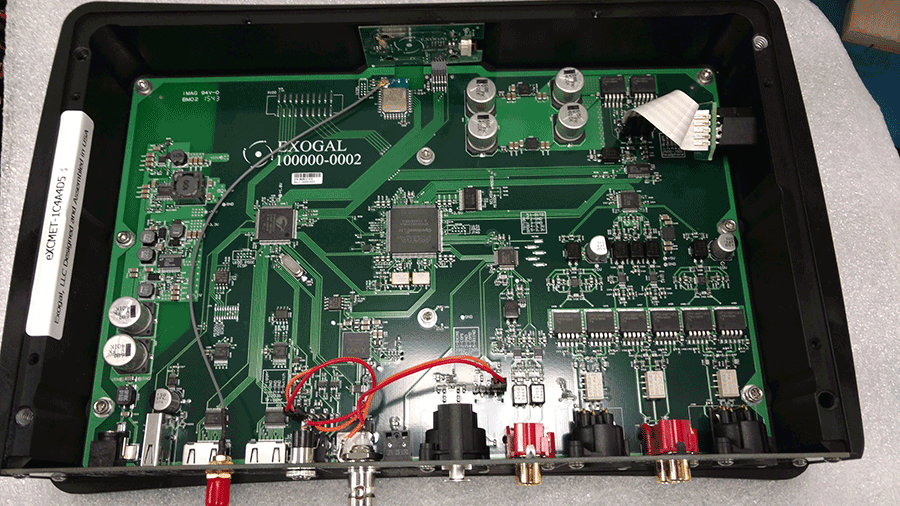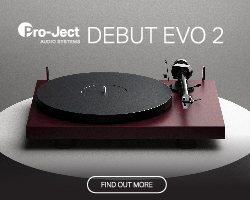David Blumenstein takes a listen to the Exogal Comet Plus DAC costing $3500 or £2500 in the UK for the DAC and £2950 with improved PSU.
For me an actor is memorable if he/she is forgettable. After all it is about the performance. I don’t remember the actor for who they are but rather who they portray. I want them to get lost in the role, in the performance, much like the late Phillip Seymour Hoffman. Almost instantaneously, he was the embodiment of Lester Bangs (editor of CREEEM) in Cameron Crowe’s opus Almost Famous.
This is how I feel about the Exogal Comet Plus DAC. I know it is there. I can see it is there, but shortly after powering up my system and selecting the music, the Comet Plus just disappears and does what is intended. No flashing lights, and with its understated minimalist display it becomes one less thing to think about and detract from enjoying the experience of listening to music. Who wants to listen to a DAC anyway? One shouldn’t and if one does there is something amiss.
The Exogal Comet Plus that I am reviewing came with the optional external power supply. I tried the unit with and without, and am now firmly in the camp that if you can, and your equipment does support an external power supply, avail yourself of the opportunity. It really does make a difference, in both soundstage and depth.
Staying on the topic of what I referred to as the clunky power supply, here’s four reasons for it, four damned good ones straight from Exogal’s CEO Jeff Haagenstad:
- The power supply noise is isolated from the computational and audio electronics.
- It allows a smaller chassis for the product (because the power supply can be tucked under the rack.
- The power supply uses a phased-array bank of capacitors where each bank releases energy based on the demands of the DAC dependent upon the frequency of the audio being converted at the moment.
- It allows customers to use their own analogue supply if they’re just dead-set against digital switching supplies.
With all the debate online, offline, and in the hallways of HiFi Shows about the efficacy of external power supplies, here I found the opportunity to have someone eloquently make the case, so I leapt at the opportunity to include the above in the review.
I met Jeff wholly by chance at AXPONA 2017 (Chicago) as I visited a room intent on listening and examining relatively affordable speakers which had been getting more than their fair share of attention online, and as it was mentioned that the music in the room was digital it took me some time before zeroing in on the DAC in the room. Exogal’s Comet Plus is quite simple in its visual design, as I alluded to in my introduction above, and I had to know more. With so many DACs on the market, I am no longer satisfied with qualitatively and subjectively better, but rather want to understand quantitatively what is different about the design, the approach to have me and prospective customers choose the Comet Plus. Not being a wallflower by any stretch I am excerpting from Jeff’s responses to my curiosities:
Jeff: ‘The essential difference in our DAC (and PowerDAC designs) has to do with how we deal with the digitized audio data. Where all other old technology DACs based on any type of DAC architecture, whether it’s Ladder, R2R, Sigma Delta or whatever all take the quantized digital data and attempt to connect the dots and rebuild the original waveform.’
Exogal’s quantization of the original analog waveform when digitized by its ADC is quite close to the original. I was supplied with a slew of technical waveform graphics and can attest to this. What follows is more from Jeff about what this means and the role of FPGA [field programmable gate array] in DAC architecture. And if it seems/appears that I am going full throttle on this, it is because I hear all too often that all DACs should sound the same, because they are all built the same. Well guess what…they are NOT!
Jeff: ‘Since our (Exogal’s) waveform is closer to the original, we can apply filtering with a much lighter touch which has less impact on the overall signal. Remember that a filter affects all data, even though its intent is to only affect the bad parts of the signal – the jagged or ragged bits.’
In Jeff’s words this is a dramatic oversimplification, but an essential difference between Exogal’s DACs and others on the market.
Jeff: ‘Other manufacturers talk about how great it is that they use FPGAs so that their DACs are field-upgradeable. The so-what about that is that they’ve simply taken textbook DAC designs and instead of using a hard-coded chip like an ESS chip, they’ve implemented the same architecture in an upgradeable chip that allows them to fiddle with the filtering on the jitter rejection but doesn’t cure the essential problem that their starting waveform is sub-optimal.’
Jeff: ‘We (Exogal) also use and FPGA, but in ours we built a 6-core DSP processor customized to do the math transforms necessary to create the curved segments and assemble them properly. Then, since we filter it more gently, our simple filters are also implemented in the FPGA and the whole thing is integrated.
Summing up, Exogal is attempting to faithfully re-create the original waveform, and in doing so can do a better job of re-creating the music as it left the mastering console and in turn closer to what the artists/musicians and recording engineer had in mind for the listener. Yes, this is a lot to take in, but in order to pull the trigger on a DAC purchase, prospective customers should know that all DACs are NOT THE SAME. There are reasons why they can indeed sound different and in essence possess their own unique sonic signature.
At this very point in time, as I write this, my listening area is populated with DACs (Exogal Comet Plus Pro, Mytek Brooklyn/Mytek Brooklyn + and exaSound e22) and to go with a raid array containing TERABYTES (let the uppercase signify more than a few) of digital audio files. I have spent a great deal of time with this DAC because of what I have learned above. I wanted to hear this for myself and in the process have swapped the other DACs in and out to hear the differences between them. On everything from redbook files all the way up and through to high resolution PCM and DSD recordings.
The music I play does not matter. It is what I like and may not be to others’ liking and that’s fine. We all have different tastes, but what we all do seem to like is depth, soundstage, separation – a natural, encompassing experience when listening to music and this is what I am getting from the Exogal Comet Plus Pro. I am playing tracks which I know intimately, ones which are indelibly etched in my mind and ears, and I’m hearing just that bit more, reaching right out at me; grabbing my attention at each successive play.
Could it be a psycho-acoustic phenomenon with what I have learned about what makes Exogal’s DACs different? Perhaps, but I seem to be forever in learning mode and the human condition dictates that this will impact both my perspective and observation, to the point that it just might alter some of my long-held beliefs.
The Comet Plus is more than a DAC. It can serve as a preamplifier as well as a headphone amplifier. This multitasking has become the norm and with that it no doubt has become expected. I prefer to look at these functionalities as gravy and not the meat and potatoes, because at the end of the day its ability to what a DAC should do, is why I would purchase the unit. Honestly if it cannot do that, I just couldn’t be bothered. Readers know that I can be slothful, so the fact that the Comet Plus can be controlled by its supplied remote control as well as by the Exogal Remote App for Android or IOS. This comes in quite handy as I sit more than arm’s reach from my gear.
Conclusion: At first glance I did know what to think. Before me, a rather plain, if not ordinary box with a barebones display. Not what I have become accustomed to in the world of DACs. There was/is nothing visually memorable in its appearance and therein lies its charm. The Comet Plus is above all else musical. It does what it says on the tin and more, and I cannot rightfully ask for more than that. With nothing to distract me I could and did relish the time spent with the DAC as it diligently recreated what I could only believe is what was intended in the studio by the recording artist(s) and at the console by the engineer.
Build Quality: The Comet Plus DAC and its Power Supply are built as we say in the States like brick outhouses – made to last. To say that the components are solid would be an understatement. Lift them up and you know you’ve got something in your hands. It is not they are hefty, but constructed in such a way to make you feel confident that they are in it for the long haul.
Sound Quality: It’s what you don’t hear. Nothing added. You get what the source provides. Sound is unadulterated. As it should be. Listening to music through the Comet Pus DAC is anything but fatiguing.
Value For Money: $3500 is a fair bit of change no matter how you slice the pie. You get what you pay for here. It’s not just money but peace of mind. Look at this way, once you accept the Comet Plus solution as part of your system, it frees you up to concern yourself with your other components.
Pros: Great sonically. Fabulous build quality. Intuitive ease of use.
Cons: For those of you who just have to play DSD 256 or unfold MQA files move along.
Price: $3500 for the Comet Plus DAC and Power Supply or £2500 in the UK for the DAC and £2950 with improved PSU.
David Blumenstein

















































































































































































































You must be logged in to leave a reply.